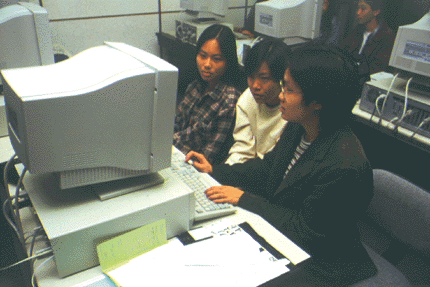Unified codingStandardized Cantonese computer coding system coming to Hong KongBy Irene Chow Auniversal Cantonese character coding system for computer applications will be introduced to the public later this year. Dr. Cheung Kwok Wai, professor in the Department of Information Engineering at The Chinese University of Hong Kong, is the director of the new coding system project. Said Dr. Cheung: “In 1994, before Netscape became popular, we saw a need for the mass media of Hong Kong to improve their information technology.”
New Cantonese coding system, available late this year, is hoped to be a milestone in computer inputting technology.At present, there are more than half a dozen Chinese character coding systems. The two most popular ones are Big 5 from Taiwan, and Guo Biao from the Mainland. But many Cantonese characters are not included in these two coding systems. In 1995, when Dr. Cheung helped some newspapers such as Ta Kung Pao to establish their web sites, problems of the incompatibility of various Cantonese character codes occurred. “There was no standard input system for Cantonese characters. Also, different publishers have different codes for the same Cantonese characters,” he said. Dr. K. P. Chan, professor in the Department of Computer Science at the University of Hong Kong, works on computer recognition of Chinese characters and Chinese document processing systems. He said, “Using different codes for the same character not only reduces the computer’s ability to read; there will also be problems in word processing. The computer might not be able to print these characters.” In 1996, the Electronic News Media and Publishing Consortium was set up by media organisations providing on-line news. The Consortium submitted a proposal to the government suggesting work on this issue. In December 1997, the Expert Group on Chinese Character Coding of the Information Infrastructure Advisory Committee also joined the project. Said Dr. Cheung: “In September 1997, we received $940,000 from the government. We expect to spend a year to finish the standardisation of Cantonese character coding. Dr. Cheung said that a code conversion filter would be created to change the input codes to standard codes. The new coding system will be submitted to the ISO 10646 Standards Committee. Then it will become an international standard coding system. “The system will probably be put in the public domain so that anyone can download it free,” said Dr. Cheung. Dr. Chan agreed that a standard system accepted by the public should be created. But he said that users should be charged for adopting the code conversion filter or the scalable font to cover the cost of the project. Dr. Cheung admitted that the subsidies are not enough. The project also needs support from the Chinese University and many volunteers from the publishing industry. Despite the cost, Dr. Cheung said that the project is a short-term one. “New characters are created continuously, and the project only deals with characters used at present,” Dr. Cheung said. “A committee monitoring the standard coding system is thus needed and is very important to the development of the publishing industry in the future,” he said. “As Big 5 and Guo Biao are not compatible, people from China and Taiwan should cooperate,” said Dr. Chan. “Then a universal Chinese character coding system, including Cantonese characters, can be developed.” In spite of the coming improvements, Dr. Chan does not encourage the use of Cantonese characters. “Words will appear on the computer like spoken rather than written language,” he said. |
